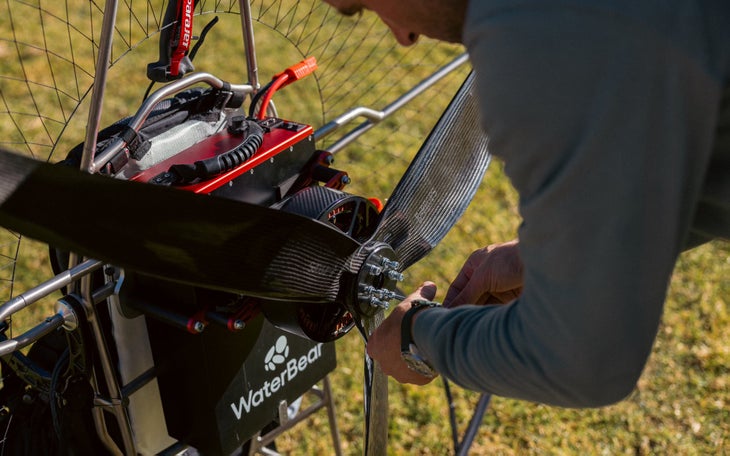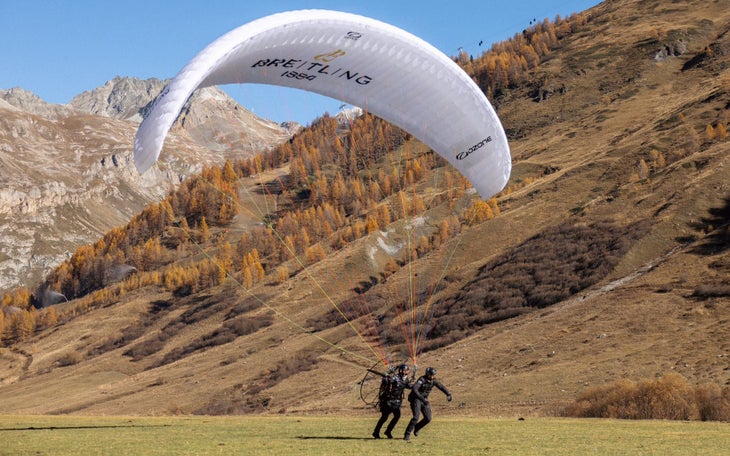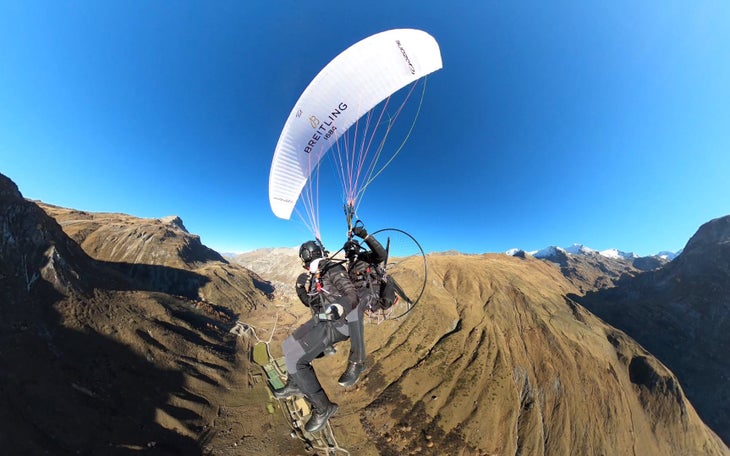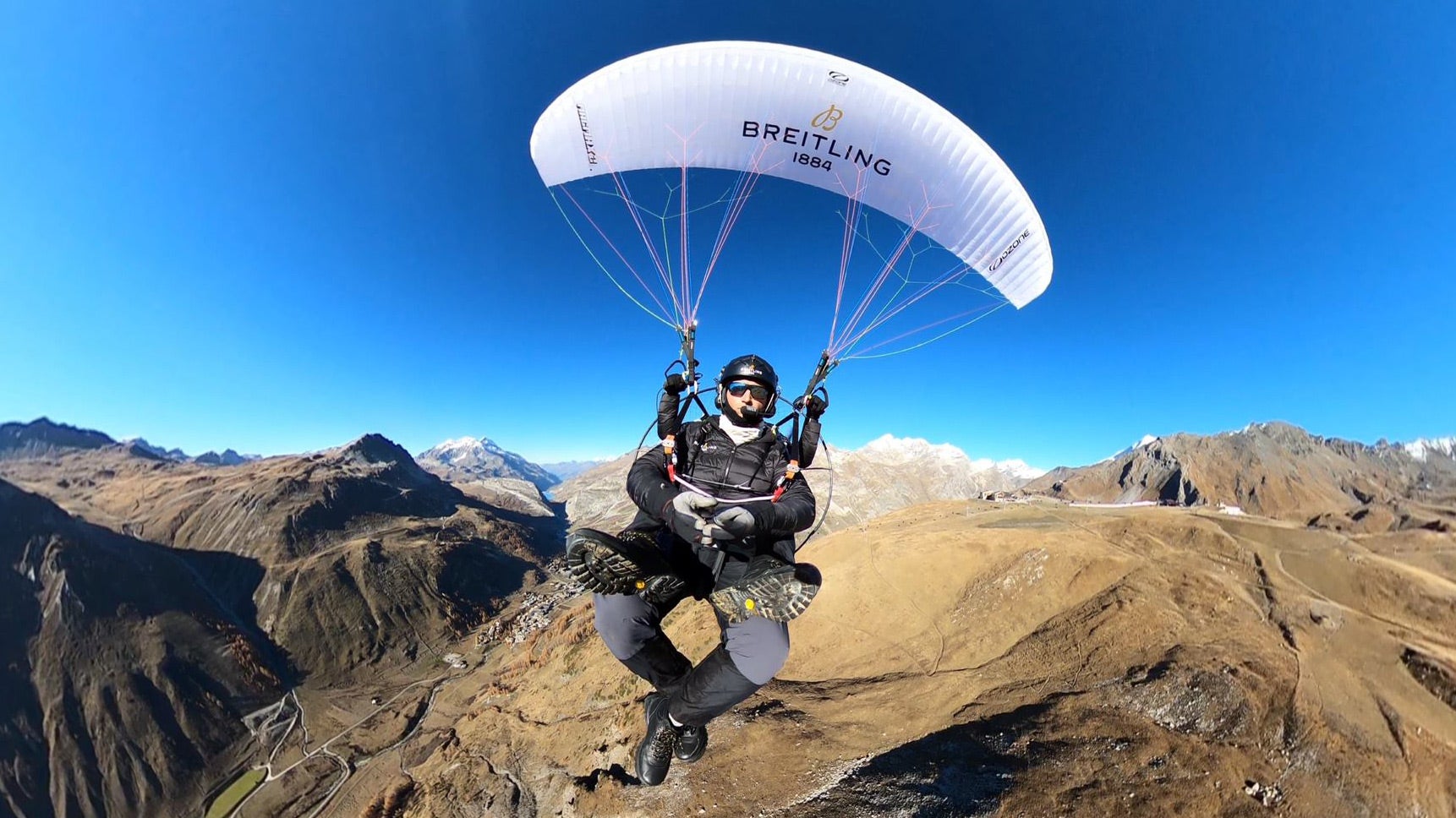On October 30, British twins Hugo and Ross Turner ascended to 8,500 feet in an electric-powered paraglider-like aircraft, called a paramotor. The brothers soared over the ski resort Val d’Isere in the French Alps.
The 34-year-olds told ���ϳԹ��� their flight set a world record for highest altitude by a tandem team in one of the battery-powered devices, and that they have submitted their flight data to the Federation Aeronautique Internationale (FAI), the governing body for air sports.
A paramotor is a steerable parachute, similar to a paraglider, outfitted with a giant rear propeller. Unlike a traditional paraglider, where pilots must launch from a cliff or hillside and catch columns of rising warm air to ascend, the motor and propeller allow pilots to take off from open, flat ground—no hills or cliffs required. “This is why paramotoring is so popular in places like the United Kingdom,” Hugo said.
Though mostly reliant on gas-powered engines, some paramotor companies are aiming to become greener. But electric batteries are notoriously heavy, and, when flying a parachute, every ounce counts. “The big challenge the industry is facing is this conscious decision that we need to move away from petrol engines,” Hugo said, “but it’s difficult to get enough battery power to make the weight justifiable.”
Although the world’s first electric paramotor was built in 2006, the technology has seen little refinement in the nearly two decades since. Most of the devices are powered by two-stroke combustion engines which burn around a gallon of gasoline per hour, and can typically fly for two-to-three hours without refueling. “To get the same flight time out of an electric paramotor, you’re talking a battery weight that a human could not physically carry,” Hugo said. “The energy density of the battery is so much that getting an extended flight time is very difficult.”

The weight is a difficult problem to solve, but even beyond concerns about emissions, there are other advantages to electric paramotors. They’re quieter, and—like electric cars and motorcycles—smoother to drive. Electric motors offer instant, consistent torque, which makes flying an electric paramotor more predictable and controlled than a gas-powered paramotor. Electric power also comes with unique advantages at high elevation. As altitude increases, air pressure decreases, causing gas-powered motors to lose thrust due to a lower oxygen-fuel ratio. Electric motors, on the other hand, maintain consistent power output regardless of elevation.
There has never been a tandem electric paramotor altitude record before, so even the relatively low elevation of 8,500 feet was enough to get the brothers in the record books. But theirs isn’t the first altitude record set in any electric paramotor. American Nathan Finneman reached 14,790 feet with an electric-powered wing in September.
Finneman was flying solo, however, and started from a much higher elevation, at over 10,000 feet in Leadville, Colorado. His paramotor battery put out 4.8 kiloWatt-hours (kWh) of power, and let him climb for 28 minutes despite brutally cold temperatures, which dropped to -13 degrees Fahrenheit with windchill. “There are a handful of electric paramotors like this out there,” Ross said, “but they’re only designed for solo flight. We wanted to look past that, and see what we could do in tandem.”
“We’re all about pushing the limits of new technology through purposeful adventure,” Ross added. “We’ve started off with a blank canvas and said, ‘What is the best emission-free technology that we could use to make a benchmark?’”

Their paramotor, dubbed the E-Maverick Max, was custom designed by United Kingdom manufacturer Parajet International. The entire rig weighed about 88 pounds, 50 pounds of which was the battery. Their motor powered a carbon fiber propeller, sporting three 4.5-foot blades. This rig gave the twins 175 pounds of thrust, pumped out by a 5.8 kWh lithium ion pouch cell battery, which ran for 35 minutes in the air.
Thirty-five minutes is a far cry from the two or three hours that a gas-powered motor could last, but it’s a start, and was even more than the 28 minutes Finneman was able to fly with his solo paramotor. Though it may not sound like much time, it’s a significant achievement considering the twins weighed a staggering 530 pounds on takeoff.
The twins launched from 6,200 feet, and though they hoped to be able to get above 10,000 feet, their flight went awry. “We weighed so much that we really struggled to gain altitude,” Ross said, noting that the World Air Sports Federation (FAI) observer watching them was surprised they even managed to take off.
“We launched from the field, and we immediately started heading down-valley, and we just dropped,” he said. “This massive pocket of cold air made us sink quite fast. Fortunately we found this ridgeline, a fork between two valleys, and we got some lift there. That’s where we stayed, working patterns between the ridgelines to keep rising.” The twins crested 8,520 feet before the battery cut out. They are currently waiting for their record to be formally verified by the FAI.

Hugo and Ross explained that, while they likely could have climbed higher if they’d started at a higher elevation, FAI altitude record stipulations required that they launch from a flat location with a 330-foot radius in all directions, a rare sight in the Alps, where the twins live. “Otherwise, we could have certainly taken off on the top of a mountain,” Hugo said. “In any case, we hope this will start a trend towards making recreational flying greener, and better for the environment.”
“Electric is unquestionably the future,” said Parajet founder Gilo Gardozo. “Now it’s a question of people adopting that reality, and the technology delivering.”


